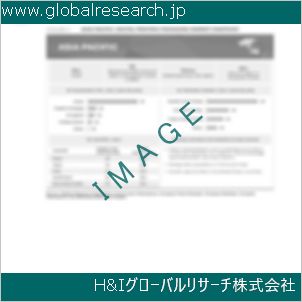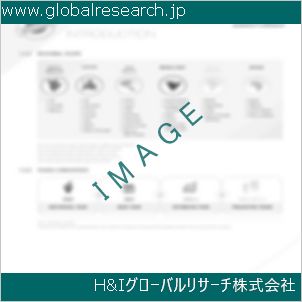1 報告の範囲
1.1 市場概要
1.2 対象期間
1.3 研究目的
1.4 市場調査手法
1.5 研究プロセスとデータソース
1.6 経済指標
1.7 対象通貨
1.8 市場推計の留意点
2 執行要約
2.1 世界市場の概要
2.1.1 グローバルなインバーター溶接機器の年間販売額(2020年~2031年)
2.1.2 地域別インバーター溶接機器の現状と将来分析(2020年、2024年、2031年)
2.1.3 地域別インバーター溶接機器の現状と将来分析(2020年、2024年、2031年)
2.2 インバーター溶接機器のセグメント別分析(タイプ別)
2.2.1 MMAインバーター溶接機
2.2.2 MIG/MAGインバーター溶接機
2.2.3 TIGインバーター溶接機
2.3 インバーター溶接機器の売上高(タイプ別)
2.3.1 グローバル インバーター溶接機器販売市場シェア(タイプ別)(2020-2025)
2.3.2 グローバル インバーター溶接機器の売上高と市場シェア(種類別)(2020-2025)
2.3.3 グローバル インバーター溶接機器の売上価格(種類別)(2020-2025)
2.4 インバーター溶接機器のセグメント別(用途別)
2.4.1 機械
2.4.2 車両
2.4.3 船舶
2.4.4 その他
2.5 インバーター溶接機器の売上高(用途別)
2.5.1 グローバルインバーター溶接機器販売市場シェア(用途別)(2020-2025)
2.5.2 アプリケーション別インバーター溶接機器の売上高と市場シェア(2020-2025)
2.5.3 アプリケーション別インバーター溶接機器の売上価格(2020-2025)
3 グローバル企業別
3.1 グローバル インバーター溶接機器の企業別内訳データ
3.1.1 グローバル インバーター溶接機器の年間販売量(企業別)(2020-2025)
3.1.2 グローバルインバーター溶接機器の売上市場シェア(企業別)(2020-2025)
3.2 グローバル インバーター溶接機器の年間売上高(企業別)(2020-2025)
3.2.1 グローバル インバーター溶接機器の企業別売上高(2020-2025)
3.2.2 グローバルインバーター溶接機器売上高市場シェア(企業別)(2020-2025)
3.3 グローバル インバーター溶接機器 販売価格(企業別)
3.4 主要メーカー インバーター溶接機器の製造地域分布、販売地域、製品タイプ
3.4.1 主要メーカー インバーター溶接機器の製品所在地分布
3.4.2 主要メーカーのインバーター溶接機器製品ラインナップ
3.5 市場集中率分析
3.5.1 競争環境分析
3.5.2 集中率(CR3、CR5、CR10)および(2023-2025)
3.6 新製品と潜在的な新規参入企業
3.7 市場M&A活動と戦略
4 地域別インバーター溶接機器の世界歴史的動向
4.1 世界インバーター溶接機器市場規模(地域別)(2020-2025)
4.1.1 地域別インバーター溶接機器の年間売上高(2020-2025)
4.1.2 地域別インバーター溶接機器の年間売上高(2020-2025)
4.2 世界インバーター溶接機器市場規模(地域別)(2020-2025)
4.2.1 地域別インバーター溶接機器の年間販売額(2020-2025)
4.2.2 グローバル インバーター溶接機器の年間売上高(地域別)(2020-2025)
4.3 アメリカズ インバーター溶接機器の売上成長率
4.4 アジア太平洋地域におけるインバーター溶接機器の販売成長
4.5 欧州のインバーター溶接機器販売成長率
4.6 中東・アフリカ地域 インバーター溶接機器の販売成長
5 アメリカ
5.1 アメリカズ インバーター溶接機器の販売額(国別)
5.1.1 アメリカ大陸のインバーター溶接機器販売額(国別)(2020-2025)
5.1.2 アメリカ大陸のインバーター溶接機器の売上高(国別)(2020-2025)
5.2 アメリカ大陸のインバーター溶接機器販売量(2020-2025)
5.3 アメリカズ インバーター溶接機器の販売量(用途別)(2020-2025)
5.4 アメリカ合衆国
5.5 カナダ
5.6 メキシコ
5.7 ブラジル
6 アジア太平洋
6.1 APAC地域別インバーター溶接機器販売額
6.1.1 APAC地域別インバーター溶接機器販売額(2020-2025)
6.1.2 APAC地域別インバーター溶接機器売上高(2020-2025)
6.2 アジア太平洋地域におけるインバーター溶接機器の販売量(2020-2025)
6.3 APACインバーター溶接機器の販売量(地域別)(2020-2025)
6.4 中国
6.5 日本
6.6 韓国
6.7 東南アジア
6.8 インド
6.9 オーストラリア
6.10 中国・台湾
7 ヨーロッパ
7.1 ヨーロッパのインバーター溶接機器の市場規模(国別)
7.1.1 欧州インバーター溶接機器の売上高(国別)(2020-2025)
7.1.2 欧州インバーター溶接機器の売上高(国別)(2020-2025)
7.2 欧州 インバーター溶接機器の売上高(種類別)(2020-2025)
7.3 欧州インバーター溶接機器の売上高(用途別)(2020-2025)
7.4 ドイツ
7.5 フランス
7.6 イギリス
7.7 イタリア
7.8 ロシア
8 中東・アフリカ
8.1 中東・アフリカ地域別インバーター溶接機器市場
8.1.1 中東・アフリカ地域におけるインバーター溶接機器の売上高(国別)(2020-2025)
8.1.2 中東・アフリカ地域におけるインバーター溶接機器の売上高(2020-2025年)
8.2 中東・アフリカ地域におけるインバーター溶接機器の売上高(2020-2025年)
8.3 中東・アフリカ地域におけるインバーター溶接機器の販売量(2020-2025年)
8.4 エジプト
8.5 南アフリカ
8.6 イスラエル
8.7 トルコ
8.8 GCC諸国
9 市場動向、課題、およびトレンド
9.1 市場ドライバーと成長機会
9.2 市場課題とリスク
9.3 業界の動向
10 製造コスト構造分析
10.1 原材料とサプライヤー
10.2 インバーター溶接機器の製造コスト構造分析
10.3 インバーター溶接機器の製造プロセス分析
10.4 インバーター溶接機器の産業チェーン構造
11 マーケティング、販売代理店および顧客
11.1 販売チャネル
11.1.1 直接チャネル
11.1.2 間接チャネル
11.2 インバーター溶接機器の卸売業者
11.3 インバーター溶接機器の顧客
12 地域別インバーター溶接機器の世界市場予測レビュー
12.1 地域別インバーター溶接機器市場規模予測
12.1.1 地域別インバーター溶接機器市場予測(2026-2031)
12.1.2 地域別インバーター溶接機器の年間売上高予測(2026-2031)
12.2 アメリカ地域別予測(2026-2031)
12.3 アジア太平洋地域別予測(2026-2031)
12.4 欧州地域別予測(2026-2031年)
12.5 中東・アフリカ地域別予測(2026-2031年)
12.6 グローバル インバーター溶接機器 タイプ別予測(2026-2031)
12.7 グローバル インバーター溶接機器市場予測(用途別)(2026-2031)
13 主要企業分析
13.1 パナソニック
13.1.1 パナソニック企業情報
13.1.2 パナソニック インバーター溶接機器の製品ポートフォリオと仕様
13.1.3 パナソニック インバーター溶接機器の売上高、収益、価格、粗利益率(2020-2025)
13.1.4 パナソニックの主要事業概要
13.1.5 パナソニックの最新動向
13.2 リンカーン
13.2.1 リンカーン会社概要
13.2.2 リンカーン インバーター溶接機器の製品ポートフォリオと仕様
13.2.3 リンカーン インバーター溶接機器の売上高、収益、価格、および粗利益率(2020-2025)
13.2.4 リンカーンの主要事業概要
13.2.5 リンカーンの最新動向
13.3 エサブ
13.3.1 エサブ会社情報
13.3.2 エサブ インバーター溶接機器の製品ポートフォリオと仕様
13.3.3 エサブ インバーター溶接機器の売上高、収益、価格、粗利益率(2020-2025)
13.3.4 エサブの主要事業概要
13.3.5 エサブの最新動向
13.4 フロニウス
13.4.1 Fronius 会社情報
13.4.2 フロニウス インバーター溶接機器の製品ポートフォリオと仕様
13.4.3 フロニウス インバーター溶接機器の売上高、収益、価格、粗利益率(2020-2025)
13.4.4 Fronius 主な事業概要
13.4.5 フロニウス 最新動向
13.5 OTC
13.5.1 OTC 会社情報
13.5.2 OTC インバーター溶接機器の製品ポートフォリオと仕様
13.5.3 OTC インバーター溶接機器の売上高、収益、価格、粗利益率(2020-2025)
13.5.4 OTC 主な事業概要
13.5.5 OTCの最新動向
13.6 ミラー
13.6.1 Miller 会社情報
13.6.2 ミラー インバーター溶接機器の製品ポートフォリオと仕様
13.6.3 ミラー インバーター溶接機器の売上高、収益、価格、粗利益率(2020-2025)
13.6.4 ミラーの主要事業概要
13.6.5 ミラーの最新動向
13.7 ミガトロン
13.7.1 ミガトロン社概要
13.7.2 ミガトロンイク インバーター溶接機器の製品ポートフォリオと仕様
13.7.3 ミガトロンイク インバーター溶接機器の売上高、収益、価格、粗利益率(2020-2025)
13.7.4 ミガトロンイクの主要事業概要
13.7.5 ミガトニックの最新動向
13.8 GYS
13.8.1 GYS 会社情報
13.8.2 GYS インバーター溶接機器の製品ポートフォリオと仕様
13.8.3 GYS インバーター溶接機器の売上高、収益、価格、および粗利益率(2020-2025)
13.8.4 GYS 主な事業概要
13.8.5 GYSの最新動向
13.9 サンシャ電気
13.9.1 サンシャ電気会社情報
13.9.2 Sansha Electric インバーター溶接機器の製品ポートフォリオと仕様
13.9.3 サンシャ電気 インバーター溶接機器の売上高、収益、価格、粗利益率(2020-2025)
13.9.4 サンシャ電気の主要事業概要
13.9.5 サンシャ電気の最新動向
13.10 アウウェルド
13.10.1 Auweld 会社情報
13.10.2 Auweld インバーター溶接機器の製品ポートフォリオと仕様
13.10.3 Auweld インバーター溶接機器の売上高、収益、価格、粗利益率(2020-2025)
13.10.4 Auweld 主な事業概要
13.10.5 Auweldの最新動向
13.11 CEA
13.11.1 CEA 会社情報
13.11.2 CEA インバーター溶接機器の製品ポートフォリオと仕様
13.11.3 CEA インバーター溶接機器の売上高、収益、価格、および粗利益率(2020-2025)
13.11.4 CEA 主な事業概要
13.11.5 CEAの最新動向
13.12 Deca
13.12.1 Deca 会社情報
13.12.2 Deca インバーター溶接機器の製品ポートフォリオと仕様
13.12.3 Deca インバーター溶接機器の売上高、収益、価格、粗利益率(2020-2025)
13.12.4 Deca 主な事業概要
13.12.5 デカの最新動向
13.13 ソハル
13.13.1 ソハル会社情報
13.13.2 ソハル インバーター溶接機器の製品ポートフォリオと仕様
13.13.3 ソハル インバーター溶接機器の売上高、収益、価格、粗利益率(2020-2025)
13.13.4 ソハルの主要事業概要
13.13.5 ソハルの最新動向
13.14 Arcraft プラズマ
13.14.1 Arcraft プラズマ 会社情報
13.14.2 Arcraft プラズマ インバーター溶接機器の製品ポートフォリオと仕様
13.14.3 Arcraft プラズマ インバーター溶接機器の売上高、収益、価格、および粗利益率(2020-2025)
13.14.4 Arcraft プラズマ 主な事業概要
13.14.5 Arcraft プラズマ 最新動向
13.15 Riland
13.15.1 Riland 会社情報
13.15.2 Riland インバーター溶接機器の製品ポートフォリオと仕様
13.15.3 Riland インバーター溶接機器の売上高、収益、価格、粗利益率(2020-2025)
13.15.4 Riland 主な事業概要
13.15.5 Rilandの最新動向
13.16 ジャシック
13.16.1 Jasic 会社情報
13.16.2 ジャシク インバーター溶接機器の製品ポートフォリオと仕様
13.16.3 ジャシク インバーター溶接機器の売上高、収益、価格、および粗利益率(2020-2025)
13.16.4 Jasic 主な事業概要
13.16.5 Jasicの最新動向
13.17 タイムグループ
13.17.1 タイムグループ会社情報
13.17.2 タイムグループ インバーター溶接機器の製品ポートフォリオと仕様
13.17.3 タイムグループ インバーター溶接機器の売上高、収益、価格、および粗利益率(2020-2025)
13.17.4 タイムグループ 主な事業概要
13.17.5 タイムグループの最新動向
13.18 HYL
13.18.1 HYL 会社情報
13.18.2 HYL インバーター溶接機器の製品ポートフォリオと仕様
13.18.3 HYL インバーター溶接機器の売上高、収益、価格、および粗利益率(2020-2025)
13.18.4 HYL 主な事業概要
13.18.5 HYLの最新動向
13.19 Kende
13.19.1 Kende 会社情報
13.19.2 Kende インバーター溶接機器の製品ポートフォリオと仕様
13.19.3 Kende インバーター溶接機器の売上高、収益、価格、粗利益率(2020-2025)
13.19.4 Kende 主な事業概要
13.19.5 ケンデの最新動向
14 研究結果と結論
14.14.1 ケンデの事業概要
1 Scope of the Report
1.1 Market Introduction
1.2 Years Considered
1.3 Research Objectives
1.4 Market Research Methodology
1.5 Research Process and Data Source
1.6 Economic Indicators
1.7 Currency Considered
1.8 Market Estimation Caveats
2 Executive Summary
2.1 World Market Overview
2.1.1 Global Inverter Welding Equipment Annual Sales 2020-2031
2.1.2 World Current & Future Analysis for Inverter Welding Equipment by Geographic Region, 2020, 2024 & 2031
2.1.3 World Current & Future Analysis for Inverter Welding Equipment by Country/Region, 2020, 2024 & 2031
2.2 Inverter Welding Equipment Segment by Type
2.2.1 MMA Inverter Welder
2.2.2 MIG/MAG Inverter Welder
2.2.3 TIG Inverter Welder
2.3 Inverter Welding Equipment Sales by Type
2.3.1 Global Inverter Welding Equipment Sales Market Share by Type (2020-2025)
2.3.2 Global Inverter Welding Equipment Revenue and Market Share by Type (2020-2025)
2.3.3 Global Inverter Welding Equipment Sale Price by Type (2020-2025)
2.4 Inverter Welding Equipment Segment by Application
2.4.1 Mechanical
2.4.2 Vehicle
2.4.3 Ship
2.4.4 Other
2.5 Inverter Welding Equipment Sales by Application
2.5.1 Global Inverter Welding Equipment Sale Market Share by Application (2020-2025)
2.5.2 Global Inverter Welding Equipment Revenue and Market Share by Application (2020-2025)
2.5.3 Global Inverter Welding Equipment Sale Price by Application (2020-2025)
3 Global by Company
3.1 Global Inverter Welding Equipment Breakdown Data by Company
3.1.1 Global Inverter Welding Equipment Annual Sales by Company (2020-2025)
3.1.2 Global Inverter Welding Equipment Sales Market Share by Company (2020-2025)
3.2 Global Inverter Welding Equipment Annual Revenue by Company (2020-2025)
3.2.1 Global Inverter Welding Equipment Revenue by Company (2020-2025)
3.2.2 Global Inverter Welding Equipment Revenue Market Share by Company (2020-2025)
3.3 Global Inverter Welding Equipment Sale Price by Company
3.4 Key Manufacturers Inverter Welding Equipment Producing Area Distribution, Sales Area, Product Type
3.4.1 Key Manufacturers Inverter Welding Equipment Product Location Distribution
3.4.2 Players Inverter Welding Equipment Products Offered
3.5 Market Concentration Rate Analysis
3.5.1 Competition Landscape Analysis
3.5.2 Concentration Ratio (CR3, CR5 and CR10) & (2023-2025)
3.6 New Products and Potential Entrants
3.7 Market M&A Activity & Strategy
4 World Historic Review for Inverter Welding Equipment by Geographic Region
4.1 World Historic Inverter Welding Equipment Market Size by Geographic Region (2020-2025)
4.1.1 Global Inverter Welding Equipment Annual Sales by Geographic Region (2020-2025)
4.1.2 Global Inverter Welding Equipment Annual Revenue by Geographic Region (2020-2025)
4.2 World Historic Inverter Welding Equipment Market Size by Country/Region (2020-2025)
4.2.1 Global Inverter Welding Equipment Annual Sales by Country/Region (2020-2025)
4.2.2 Global Inverter Welding Equipment Annual Revenue by Country/Region (2020-2025)
4.3 Americas Inverter Welding Equipment Sales Growth
4.4 APAC Inverter Welding Equipment Sales Growth
4.5 Europe Inverter Welding Equipment Sales Growth
4.6 Middle East & Africa Inverter Welding Equipment Sales Growth
5 Americas
5.1 Americas Inverter Welding Equipment Sales by Country
5.1.1 Americas Inverter Welding Equipment Sales by Country (2020-2025)
5.1.2 Americas Inverter Welding Equipment Revenue by Country (2020-2025)
5.2 Americas Inverter Welding Equipment Sales by Type (2020-2025)
5.3 Americas Inverter Welding Equipment Sales by Application (2020-2025)
5.4 United States
5.5 Canada
5.6 Mexico
5.7 Brazil
6 APAC
6.1 APAC Inverter Welding Equipment Sales by Region
6.1.1 APAC Inverter Welding Equipment Sales by Region (2020-2025)
6.1.2 APAC Inverter Welding Equipment Revenue by Region (2020-2025)
6.2 APAC Inverter Welding Equipment Sales by Type (2020-2025)
6.3 APAC Inverter Welding Equipment Sales by Application (2020-2025)
6.4 China
6.5 Japan
6.6 South Korea
6.7 Southeast Asia
6.8 India
6.9 Australia
6.10 China Taiwan
7 Europe
7.1 Europe Inverter Welding Equipment by Country
7.1.1 Europe Inverter Welding Equipment Sales by Country (2020-2025)
7.1.2 Europe Inverter Welding Equipment Revenue by Country (2020-2025)
7.2 Europe Inverter Welding Equipment Sales by Type (2020-2025)
7.3 Europe Inverter Welding Equipment Sales by Application (2020-2025)
7.4 Germany
7.5 France
7.6 UK
7.7 Italy
7.8 Russia
8 Middle East & Africa
8.1 Middle East & Africa Inverter Welding Equipment by Country
8.1.1 Middle East & Africa Inverter Welding Equipment Sales by Country (2020-2025)
8.1.2 Middle East & Africa Inverter Welding Equipment Revenue by Country (2020-2025)
8.2 Middle East & Africa Inverter Welding Equipment Sales by Type (2020-2025)
8.3 Middle East & Africa Inverter Welding Equipment Sales by Application (2020-2025)
8.4 Egypt
8.5 South Africa
8.6 Israel
8.7 Turkey
8.8 GCC Countries
9 Market Drivers, Challenges and Trends
9.1 Market Drivers & Growth Opportunities
9.2 Market Challenges & Risks
9.3 Industry Trends
10 Manufacturing Cost Structure Analysis
10.1 Raw Material and Suppliers
10.2 Manufacturing Cost Structure Analysis of Inverter Welding Equipment
10.3 Manufacturing Process Analysis of Inverter Welding Equipment
10.4 Industry Chain Structure of Inverter Welding Equipment
11 Marketing, Distributors and Customer
11.1 Sales Channel
11.1.1 Direct Channels
11.1.2 Indirect Channels
11.2 Inverter Welding Equipment Distributors
11.3 Inverter Welding Equipment Customer
12 World Forecast Review for Inverter Welding Equipment by Geographic Region
12.1 Global Inverter Welding Equipment Market Size Forecast by Region
12.1.1 Global Inverter Welding Equipment Forecast by Region (2026-2031)
12.1.2 Global Inverter Welding Equipment Annual Revenue Forecast by Region (2026-2031)
12.2 Americas Forecast by Country (2026-2031)
12.3 APAC Forecast by Region (2026-2031)
12.4 Europe Forecast by Country (2026-2031)
12.5 Middle East & Africa Forecast by Country (2026-2031)
12.6 Global Inverter Welding Equipment Forecast by Type (2026-2031)
12.7 Global Inverter Welding Equipment Forecast by Application (2026-2031)
13 Key Players Analysis
13.1 Panasonic
13.1.1 Panasonic Company Information
13.1.2 Panasonic Inverter Welding Equipment Product Portfolios and Specifications
13.1.3 Panasonic Inverter Welding Equipment Sales, Revenue, Price and Gross Margin (2020-2025)
13.1.4 Panasonic Main Business Overview
13.1.5 Panasonic Latest Developments
13.2 Lincoln
13.2.1 Lincoln Company Information
13.2.2 Lincoln Inverter Welding Equipment Product Portfolios and Specifications
13.2.3 Lincoln Inverter Welding Equipment Sales, Revenue, Price and Gross Margin (2020-2025)
13.2.4 Lincoln Main Business Overview
13.2.5 Lincoln Latest Developments
13.3 Esab
13.3.1 Esab Company Information
13.3.2 Esab Inverter Welding Equipment Product Portfolios and Specifications
13.3.3 Esab Inverter Welding Equipment Sales, Revenue, Price and Gross Margin (2020-2025)
13.3.4 Esab Main Business Overview
13.3.5 Esab Latest Developments
13.4 Fronius
13.4.1 Fronius Company Information
13.4.2 Fronius Inverter Welding Equipment Product Portfolios and Specifications
13.4.3 Fronius Inverter Welding Equipment Sales, Revenue, Price and Gross Margin (2020-2025)
13.4.4 Fronius Main Business Overview
13.4.5 Fronius Latest Developments
13.5 OTC
13.5.1 OTC Company Information
13.5.2 OTC Inverter Welding Equipment Product Portfolios and Specifications
13.5.3 OTC Inverter Welding Equipment Sales, Revenue, Price and Gross Margin (2020-2025)
13.5.4 OTC Main Business Overview
13.5.5 OTC Latest Developments
13.6 Miller
13.6.1 Miller Company Information
13.6.2 Miller Inverter Welding Equipment Product Portfolios and Specifications
13.6.3 Miller Inverter Welding Equipment Sales, Revenue, Price and Gross Margin (2020-2025)
13.6.4 Miller Main Business Overview
13.6.5 Miller Latest Developments
13.7 Migatronic
13.7.1 Migatronic Company Information
13.7.2 Migatronic Inverter Welding Equipment Product Portfolios and Specifications
13.7.3 Migatronic Inverter Welding Equipment Sales, Revenue, Price and Gross Margin (2020-2025)
13.7.4 Migatronic Main Business Overview
13.7.5 Migatronic Latest Developments
13.8 GYS
13.8.1 GYS Company Information
13.8.2 GYS Inverter Welding Equipment Product Portfolios and Specifications
13.8.3 GYS Inverter Welding Equipment Sales, Revenue, Price and Gross Margin (2020-2025)
13.8.4 GYS Main Business Overview
13.8.5 GYS Latest Developments
13.9 Sansha Electric
13.9.1 Sansha Electric Company Information
13.9.2 Sansha Electric Inverter Welding Equipment Product Portfolios and Specifications
13.9.3 Sansha Electric Inverter Welding Equipment Sales, Revenue, Price and Gross Margin (2020-2025)
13.9.4 Sansha Electric Main Business Overview
13.9.5 Sansha Electric Latest Developments
13.10 Auweld
13.10.1 Auweld Company Information
13.10.2 Auweld Inverter Welding Equipment Product Portfolios and Specifications
13.10.3 Auweld Inverter Welding Equipment Sales, Revenue, Price and Gross Margin (2020-2025)
13.10.4 Auweld Main Business Overview
13.10.5 Auweld Latest Developments
13.11 CEA
13.11.1 CEA Company Information
13.11.2 CEA Inverter Welding Equipment Product Portfolios and Specifications
13.11.3 CEA Inverter Welding Equipment Sales, Revenue, Price and Gross Margin (2020-2025)
13.11.4 CEA Main Business Overview
13.11.5 CEA Latest Developments
13.12 Deca
13.12.1 Deca Company Information
13.12.2 Deca Inverter Welding Equipment Product Portfolios and Specifications
13.12.3 Deca Inverter Welding Equipment Sales, Revenue, Price and Gross Margin (2020-2025)
13.12.4 Deca Main Business Overview
13.12.5 Deca Latest Developments
13.13 Sohal
13.13.1 Sohal Company Information
13.13.2 Sohal Inverter Welding Equipment Product Portfolios and Specifications
13.13.3 Sohal Inverter Welding Equipment Sales, Revenue, Price and Gross Margin (2020-2025)
13.13.4 Sohal Main Business Overview
13.13.5 Sohal Latest Developments
13.14 Arcraft plasma
13.14.1 Arcraft plasma Company Information
13.14.2 Arcraft plasma Inverter Welding Equipment Product Portfolios and Specifications
13.14.3 Arcraft plasma Inverter Welding Equipment Sales, Revenue, Price and Gross Margin (2020-2025)
13.14.4 Arcraft plasma Main Business Overview
13.14.5 Arcraft plasma Latest Developments
13.15 Riland
13.15.1 Riland Company Information
13.15.2 Riland Inverter Welding Equipment Product Portfolios and Specifications
13.15.3 Riland Inverter Welding Equipment Sales, Revenue, Price and Gross Margin (2020-2025)
13.15.4 Riland Main Business Overview
13.15.5 Riland Latest Developments
13.16 Jasic
13.16.1 Jasic Company Information
13.16.2 Jasic Inverter Welding Equipment Product Portfolios and Specifications
13.16.3 Jasic Inverter Welding Equipment Sales, Revenue, Price and Gross Margin (2020-2025)
13.16.4 Jasic Main Business Overview
13.16.5 Jasic Latest Developments
13.17 Time Group
13.17.1 Time Group Company Information
13.17.2 Time Group Inverter Welding Equipment Product Portfolios and Specifications
13.17.3 Time Group Inverter Welding Equipment Sales, Revenue, Price and Gross Margin (2020-2025)
13.17.4 Time Group Main Business Overview
13.17.5 Time Group Latest Developments
13.18 HYL
13.18.1 HYL Company Information
13.18.2 HYL Inverter Welding Equipment Product Portfolios and Specifications
13.18.3 HYL Inverter Welding Equipment Sales, Revenue, Price and Gross Margin (2020-2025)
13.18.4 HYL Main Business Overview
13.18.5 HYL Latest Developments
13.19 Kende
13.19.1 Kende Company Information
13.19.2 Kende Inverter Welding Equipment Product Portfolios and Specifications
13.19.3 Kende Inverter Welding Equipment Sales, Revenue, Price and Gross Margin (2020-2025)
13.19.4 Kende Main Business Overview
13.19.5 Kende Latest Developments
14 Research Findings and Conclusion
| ※参考情報 インバータ溶接装置は、現代の溶接技術において非常に重要な役割を果たす機器の一つです。従来の溶接技術に比べて、インバータ技術を利用することで、効率的かつ高品質な溶接作業が可能になります。本稿では、インバータ溶接装置の概念について、その定義、特徴、種類、用途、さらに関連技術について詳しく説明します。 まず、インバータ溶接装置の定義から始めましょう。この装置は、AC(交流)電源を利用して、直流(DC)電源に変換するインバータ技術を用いて、溶接のための電流を供給する装置です。インバータ技術の導入により、電流の制御が非常に細かくできるため、様々な溶接条件に応じた最適な設定が可能です。この結果、使用者は高精度かつ高効率な溶接作業を行うことができます。 次に、インバータ溶接装置の特徴について述べます。一つ目の特徴は、そのコンパクトさです。従来型の溶接機器に比べて、インバータ装置は小型軽量であるため、移動や設置が容易です。現場での作業においては、小さなスペースでも使用できる利点があります。二つ目の特徴は、高効率な電源利用です。インバータ技術により、従来のトランス方式に比べてエネルギー損失が少なく、電力効率が高まります。これにより、長時間の使用でも運転コストが抑えられるメリットがあります。 また、インバータ溶接装置は、電流の波形が非常に安定しているため、溶接ビードの品質が向上します。さらに、電流の変化に応じて素早く応答できるため、溶接中の温度管理が容易になり、熱影響が少ないという利点も存在します。このように、インバータ装置は精度と効率を兼ね備えており、業界内での評価が高まっています。 次に、インバータ溶接装置の種類について考察します。一般的に、インバータ溶接装置は主に以下のタイプに分類されます。まずは、MIG/MAG溶接(ガス金属アーク溶接)用のインバータ装置です。このタイプは、金属を電気的に溶接する際に、常に溶接ワイヤを供給し、ガスを用いて酸化を防ぐ方式です。この方法は、薄板の溶接に優れ、スピーディーに作業を進められることから、幅広い産業で使用されています。 次に、TIG溶接(タングステン不活性ガス溶接)用のインバータ装置があります。このタイプは、タングステン電極を使用し、不活性ガス(通常はアルゴン)を用いた溶接方法で、鋳鋼、ステンレス鋼、アルミニウムなどの高精度な溶接が求められる場合に適しています。最後に、アーク溶接(手動電気アーク溶接)用のインバータ装置もあり、比較的単純な作業で使用されることが多いですが、パワーが必要な場合によく用いられます。 インバータ溶接装置の用途は非常に広範囲にわたります。自動車産業や船舶製造、建設業など、金属加工が必要な分野では欠かせない機器となっています。また、家庭用のDIYプロジェクトやアマチュア溶接にも活用されるため、個人でも手軽に利用できる点が人気を博しています。さらに、多くの工業製品の製造過程においても、インバータ溶接技術は重要な役割を果たしています。 関連技術についても触れておく必要があります。インバータ溶接技術は、電子制御技術、センサー技術、そしてコンピュータ制御技術などと密接に関連しています。これらの技術の進展により、より精密で安定した溶接プロセスが実現されており、さらに、IoT(インターネット・オブ・シングス)の導入が進む中で、溶接機器の監視や管理が遠隔で行えるようにもなっています。このように、インバータ溶接装置は単なる溶接機器を超えた、高度な技術の結晶であると言えるでしょう。 総じて、インバータ溶接装置は、その高効率、小型化、精度の高さといった特長により、現代の多様な産業において不可欠な存在となっています。溶接技術の発展とともに、その役割はますます重要になっており、今後も新しい技術との融合が期待されます。これまでの溶接技術に比べて進化したこの装置は、未来の溶接プロセスを革新する力を秘めています。 |
❖ 免責事項 ❖
http://www.globalresearch.jp/disclaimer












